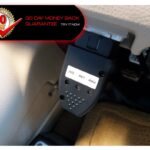Encountering issues when trying to connect your OBD2 scanner to your vehicle’s ECU can be a frustrating experience for any car owner. You’ve got your diagnostic tool in hand, ready to read trouble codes and understand what’s going on under the hood, but the scanner simply refuses to communicate. If you’re using a Tacklife OBD2 scanner and running into connection problems, you’re not alone. Many users, from seasoned mechanics to DIY enthusiasts, sometimes face this hurdle. Let’s explore common reasons why your Tacklife scanner might not be connecting and how to troubleshoot these issues effectively.
Understanding OBD2 Scanner Connection Issues
Before diving into brand-specific troubleshooting, it’s crucial to understand why OBD2 scanners, including Tacklife models, might fail to establish a connection with your car’s Engine Control Unit (ECU). Several factors can contribute to this problem:
- ECU Issues: In some rare scenarios, the ECU itself might be malfunctioning or in a state that prevents communication. This could be due to electrical problems, software glitches, or even physical damage.
- Protocol Mismatches: OBD2 scanners and ECUs communicate using various protocols. While Tacklife scanners are designed to be universally compatible, there might be instances where a protocol mismatch occurs, especially in older or non-standard vehicles.
- Scanner Malfunction: Although less common, the OBD2 scanner itself could be faulty. Internal hardware or software problems within the Tacklife scanner can prevent it from establishing a connection.
- Power Supply Problems: Both the scanner and the ECU need a stable power supply to communicate. Low battery voltage in the car or issues with the OBD2 port’s power can disrupt the connection.
- Wiring and Connector Problems: Damaged wiring to the OBD2 port or corrosion within the connector can also lead to communication failures.
Tacklife OBD2 Scanner and Connection Troubleshooting
When your Tacklife OBD2 scanner fails to connect, follow these troubleshooting steps to pinpoint and resolve the issue:
- Verify Scanner and Vehicle Compatibility: Double-check that your Tacklife OBD2 scanner is compatible with your vehicle’s make, model, and year. While OBD2 is a standard, some very specific or older models might present compatibility challenges. Refer to your Tacklife scanner’s manual for compatibility details.
- Ensure Proper Connection: Make sure the Tacklife scanner is firmly plugged into the OBD2 port, usually located under the dashboard on the driver’s side. A loose connection is a common cause of communication failure.
- Check Vehicle Ignition: For most OBD2 scanners to work, the vehicle’s ignition needs to be in the “ON” position (sometimes referred to as “Accessory” or “Key On, Engine Off” – KOEO). Simply having the key in the ignition or the car completely off will usually not power the OBD2 port correctly for data communication.
- Test on Another Vehicle: If possible, try connecting your Tacklife scanner to a different vehicle that you know is OBD2 compliant and functional. This will help you determine if the issue is with the scanner itself or the original vehicle.
- Inspect the OBD2 Port: Visually inspect the OBD2 port in your car for any signs of damage, bent pins, or corrosion. Clean the port carefully if you notice any debris or corrosion.
- Check Car Battery Voltage: A low car battery can sometimes prevent the ECU from communicating properly with a scanner. Ensure your car battery is adequately charged and in good condition. Consider testing the battery voltage with a multimeter.
- Perform an ECU Reset (Caution Advised): In some cases, a temporary ECU glitch might be preventing communication. Disconnecting the car battery for about 15-20 minutes can sometimes reset the ECU. However, be aware that this might also reset other electronic systems in your car, such as radio presets and security systems. Consult your vehicle’s manual before attempting a battery disconnect.
- Consult a Professional: If you’ve tried these steps and your Tacklife scanner still won’t connect, there might be a more complex issue at play, such as an ECU malfunction or deeper electrical problems. It’s advisable to seek assistance from a qualified mechanic or a professional automotive diagnostic service.
Potential Causes for Connection Failure: Learning from a Real-World Scenario
Consider a situation where a car owner experienced repeated OBD2 connection failures after a battery-related incident. In this case, a Nissan 370Z owner reported that after jump-starting their car following a battery drain, they encountered a “limp mode” issue and subsequently, neither their Tacklife wifi scanner nor another scanner could connect to the ECU.
This real-world example highlights several potential areas to investigate when faced with OBD2 connection problems:
- Battery Health and Voltage: The Nissan dealer initially resolved the issue by replacing the battery, suggesting that battery voltage or internal resistance could indeed impact ECU communication. Even if a battery seems to start the car, it might not be providing stable power for diagnostics.
- Electrical System Issues Post-Jump Start: While jump-starting a car is common practice, it can sometimes cause electrical surges. Although less frequent, these surges could potentially affect sensitive electronic components, including the ECU or related wiring, leading to communication problems. It’s worth considering if any electrical components might have been stressed during or after the jump start.
- ECU State and “Limp Mode”: The “limp mode” experienced by the 370Z indicates that the ECU has detected a fault and entered a protective state. It’s conceivable that in certain severe fault conditions, the ECU might temporarily restrict or alter its communication protocols as a safety measure.
Conclusion
Troubleshooting OBD2 scanner connection issues, especially with a reliable tool like a Tacklife scanner, involves a systematic approach. By checking compatibility, ensuring proper connections, verifying power, and considering potential vehicle-specific electrical issues, you can often identify and resolve the problem. Remember to prioritize safety and consult a professional if you’re uncomfortable working on your car’s electrical system or if the problem persists despite your troubleshooting efforts. Understanding the potential interplay between your car’s electrical health and diagnostic communication is key to effectively using your Tacklife OBD2 scanner and keeping your vehicle running smoothly.
